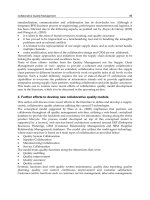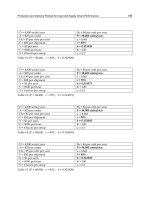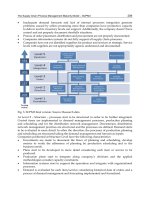Individual Assignment Nike Supply Chain Management.pdf
Bạn đang xem bản rút gọn của tài liệu. Xem và tải ngay bản đầy đủ của tài liệu tại đây (1.2 MB, 12 trang )
<span class="text_page_counter">Trang 1</span><div class="page_container" data-page="1">
INDIVIDUAL ASSIGNMENT*****
<b>NIKE SUPPLY CHAIN MANAGEMENT</b>
COURSE: SCM201
</div><span class="text_page_counter">Trang 2</span><div class="page_container" data-page="2">CONCLUSION...11
</div><span class="text_page_counter">Trang 3</span><div class="page_container" data-page="3">Nike, Inc. is an American multinational corporation that designs, develops, manufactures,markets, and sells footwear, apparel, equipment, accessories, and services worldwide. Thecompany was founded in 1964 by William Jay Bowerman and Philip H. Knight andheadquartered in the Portland metropolitan area, near Beaverton, Oregon. Nike currently hassubsidiaries in over 200 countries. Along with the famous brand Nike, Nike Group also owns asystem of subsidiaries with other famous brands in the world such as Cole Haan, Converse, Inc,Hurley, LLC, Nike Goft, etc.
According to Nike Financial Summary 2022 on Forbes, their financial ratio included revenue of$46.9 billion, assets of $38.6 billion and profits of $6.1 billion, it became the world's largestsupplier of athletic shoes - apparel and a major manufacturer of sports equipment.
Every corporation has always understood that owning a strong supply chain is a competitiveadvantage over other competitors in the business. In other words, supply chain management is nolonger an operational function of leading companies but becomes a strategic part of the company.Understanding this, Nike has identified, built and developed their supply chain into a competitiveadvantage.
Since 2005 until now, Nike's supply chain has achieved many great successes. Along with Apple,Nike's supply chain is considered one of the most efficient supply chains today. According to TheGartner Supply Chain Top 25 for 2022, Nike ranked 13th best supply chain worldwide based onscores on key attributes such as ESG, three-year weight return on physical assets (ROPA),revenue growth and inventory turns[ CITATION Mik22 \l 1033 ].
</div><span class="text_page_counter">Trang 4</span><div class="page_container" data-page="4">By investing in the supply chain as a competitive advantage, Nike hopes to reduce the time fromorder receipt to final product delivery to the retailer. Moreover, this investment will help thesupply chain become leaner (lean supply chain) and better able to quickly respond to customerneeds.
Nike's manufacturing process is as follows: Nike researches and designs the product thendelivers the model to factories for mass production. After that, the product will be transferred tothe Nike company, from where Nike will carry out the process of distributing and sellingproducts. Nike sells their products through their own retail stores and digital platforms, to retailaccounts and through a mix of independent distributors, licensees and sales representatives invirtually all countries around the world. Virtually all of the products are manufactured by
<b>independent contract manufacturers [ CITATION Nik22 \l 1033 ].</b>
</div><span class="text_page_counter">Trang 5</span><div class="page_container" data-page="5">‘To bring inspiration and innovation to every athlete* in the world.*If you have a body, you are an athlete.’ [ CITATION Nik \l 1033 ]
This philosophy drives Nike to do everything possible to expand human potential. They do thatby creating groundbreaking sport innovations, by making their products more sustainable, bybuilding a creative and diverse global team and by making a positive impact in communitieswhere they live and work.
Supply chain relationship management: tracking the work results of hundreds of manufacturersand thousands of retailers is not easy. Therefore, Nike determines that the cooperation betweenthe company and related units needs to be planned transparently and clearly.
Non-stop innovation: John Donahoe, President and CEO of Nike once mentioned that ‘NIKE is,and always will be, a brand of action. We don’t just say we want to create positive change in theworld—we set out to do it. And so long as we can help shape a brighter future, we will neverstop working to do better.’[ CITATION Nik221 \l 1033 ]
</div><span class="text_page_counter">Trang 6</span><div class="page_container" data-page="6">Cost reduction
Outsourcing: sneakers are one of the most labor-intensive products, and with the sky-high laborcosts in the US and Europe, making shoes in these two biggest markets is almost suicide.Because of that, nearly 99% of sports shoes in the US are manufactured abroad. A supply chainthat completely outsources production helps Nike reduce direct labor costs, infrastructureconstruction costs, and administrative costs. According to Nike’s manufacturing map, most oftheir factories are concentrated in Asian countries such as China, Indonesia, Vietnam,Philippines, Taiwan, Korea. Furthermore, thanks to the expansion of the manufacturing marketby outsourcing, Nike has the flexibility to switch suppliers at a lower cost.
Moreover, Nike forced more than 85% of their manufacturing partners to adopt the leanmanufacturing method and achieve their #1 priority - cutting costs. All of the above efforts havehelped them save 0.15 USD (about 3,500 VND) for each of their shoes. The seeminglyinsignificant number will be multiplied with more than 900 million products released each year,providing a unique competitive advantage in the market[ CITATION LêT19 \l 1033 ].
</div><span class="text_page_counter">Trang 7</span><div class="page_container" data-page="7">Inventory control: Nike only proceeds with production when there is certain confirmation ofpurchases from retailers. As a result, they have reduced the percentage of goods needed to beproduced, helping to reduce inventory from 30% to 3%[ CITATION MIS22 \l 1033 ]. Moreover,Nike Factory Outlet Store and Clearance Store, which were founded to deal with large inventory,obsolete and defective products will sell these products with a price that is lower than the settingone.
</div><span class="text_page_counter">Trang 8</span><div class="page_container" data-page="8">desires of consumers, thereby chasing after market trends and continuously improving productquality.
Management and handling returned items: returns are not conducted by many businesses due tothe relatively high two-way shipping costs. However, nowadays, many companies see it as along-term competitive strategy. Customers tend to give more trust to businesses that provideexchange and return services. In the long run, the brand reputation and customer loyalty will beenhanced.
Stable manufacturing cycle
Nike invests heavily in technology and information systems to avoid the risk of interruption ateach link in the chain. Besides, they also choose a risk manager for each link to ensuremanufacturing continuity.
Investing in technology Nike rarely employs direct workers. Instead, there are modern "Robot":
machines called Grabit with 20 times more productivity than humans with an error rate ofapproximately 0[ CITATION VũM21 \l 1033 ]. In Nike's factory, humans only supervise,manage and control devices. Everything is almost completely automated to save time and hugelabor costs.
Investing information system for the supply chain backbone, Nike invested $500 million to: build a new information system to replace the old one. As a result, design and production wereaccelerated and profits increased 42.9% in 2003, compared with an average of 39.9% over theprevious five years [ CITATION AMI22 \l 1033 ].
Longer-term supplier relationship
Nike, Inc. Statement on Force Labor, Human Trafficking and Modern Slavery for Fiscal Year2022 has shown that the corporate wish to grow the business through long-term relationship with
</div><span class="text_page_counter">Trang 9</span><div class="page_container" data-page="9">suppliers. To implement this wish, Nike selects suppliers based on certain criteria such asbusiness sustainability, environmental impact, human rights, cost and quality of raw materials,etc. In addition, Nike will keep the list of material suppliers to manage quality and price. Nike’s5 major suppliers include Pou Chen, PT Pan Brothers, Fulgent Sun International, Delta Galil andEagle Nice[ CITATION JWI22 \l 1033 ].
Outsourcing: dramatically cutting production costs helps Nike get more profit per product andhas more time to invest in the company's strengths: customer research and product design.Besides, thanks to outsourcing, Nike could flexibly switch suppliers at a favorable price, accessdifferent technologies and expand the market by reaching many potential customers.
Lean manufacturing: reducing waste, improving efficiency in production and cutting inventory. D2C: directly selling helps Nike to access more customers’ data to analyze and understandconsumer purchasing patterns, timely innovate, and capture opportunities.
Digitalization: Nike's heavy investment in technology helps the supply cycle continue smoothly.Besides, Nike also takes advantage of technology to predict future demand and create a backupplan for the worst scenarios.
Supply chain complexity: including many components such as multiple suppliers, factories, anddistribution centers that make it difficult to manage the entire chain.
</div><span class="text_page_counter">Trang 10</span><div class="page_container" data-page="10">Outsourcing risk: local laws, regional exchange rate differences, product quality issues, lack ofpotential employees, etc. Moreover, geographical barriers sometimes prevent Nike from gettingthe necessary information in time when encountering problems.
Ethical concerns: criticism for using sweatshops and illegal labor to deal with mass production.Environment impact: though Nike has made efforts to reduce the impact, their supply chain stillhas a significant carbon footprint due to transportation, energy consumption and industrial waste.
Concerning employees: opening training courses, upgrading the working environment, settingout incentive policies to improve the staff qualifications.
The supply chain occupies an irreplaceable position for trading and manufacturing enterprises.An effective supply model will make the process of providing goods to consumers moreconvenient and faster. Nike's supply chain possesses most of the advantages that almost everycompany wants, especially effective cost optimization without affecting quality or chainoperation. Besides, the cumbersome supply chain model and the risk of outsourcing are two
</div><span class="text_page_counter">Trang 11</span><div class="page_container" data-page="11">major disadvantages that Nike needs to overcome. By implementing the aboverecommendations, Nike can somewhat improve their supply engine and maintain theircompetitive position in the market.
<b>REFERENCES </b>
AMICA, 2022. Chuỗi quản trị cung ứng: Những bài học từ Nike. [Online]
Available at: AMIS, M., 2022. Chuỗi cung ứng của Nike – Mơ hình cung ứng hiệu quả hàng đầu. [Online] Available at:
CARPENTER, J. W., 2022. Nike Stock: Analyzing 5 Key Suppliers (NKE). [Online]
Available at: suppliers-nke.asp#citation-16
M., 2022. The Gartner Supply Chain Top 25 for 2022. [Online]
Available at: V. M., 2021. Khám phá quy trình sản xuất giày thể thao Nike với quy tắc vàng ấn tượng!. [Online]
Available at: tuong-1856.html
2022. A Letter from Our President and CEO. [Online] Available at: A Letter from Our President and CEO
Nike, 2022. NIKE, INC. STATEMENT ON FORCED LABOR, HUMAN TRAFFICKING ANDMODERN SLAVERY FOR FISCAL YEAR 2022. [Online]
</div><span class="text_page_counter">Trang 12</span><div class="page_container" data-page="12">Available at:
file:///C:/Users/admin/Downloads/NIKE_Inc_Statement_Forced_Labor_Human_Trafficking_Modern_Slavery_FY22_11.30.2022.pdf
Nike, n.d. A CULTURE OF INNOVATION. [Online]
Available at: n.d. WHAT IS NIKE'S MISSION?. [Online]
Available at:
Sang, L. T., 2017. Bài tốn chi phí và giá thành trên mỗi đôi giày Nike & Adidas. [Online] Available at: L. T., 2019. Cắt giảm chi phí chuỗi cung ứng, Nike tạo ra tỷ suất lợi nhuận vượt trội. [Online]
Available at: tao-ra-ty-suat-loi-nhuan-vuot-troi
</div>








